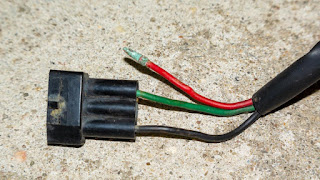Although the temporary guest is also in need of
some attention, I decided to spend some time on my own project. And one of the
jobs that was waiting to be finished were the front side lights. During my
(late) summer holidays I collected my spare lights from the shed. And after
inspecting them, I decided that it was best to dismantle them completely and
refurbish two complete sets (leaving me with one spare set). So I started with
dismantling the chosen units.
To take them apart you first have to remove the connectors. Not too difficult using the correct tools. Though some connector pins didn’t need tools, as they fell apart at the slightest pull. One of the reasons why I always place the connectors well out of harm’s way!
With the connector blocks removed the connectors themselves were unceremoniously cut off. They were too far gone to be of any future use. And removing them enabled me to remove the rubber boots, and the wires plus contact points for the bulbs, from the armatures.
And after an evening of pulling the armatures apart, including drilling out a few lens screws, removing all mounting bolts (or their remains), and hammering out some dents, I was left with various assorted parts:
The lenses of course won’t be used as I finished a pair of these for the car almost half a year ago. So the lenses pictured above will be for the spares department. Same applies for the gaskets. These will be replaces with new ones.
The final stage for this part of the front side
light refurbishment was a trip to a friend’s work shop and his bead blasting
cabinet. But first one of the armatures had to be cleaned of a thick layer of under body seal. The final process of bead blasting the four chosen armatures
was rather straightforward. Though much more time consuming than expected. The
rather old blasting medium and a slowly emerging blockage in the nozzle didn’t
help here. But I got there in the end. This should give a good base for the
next stages, painting and assembling of the armatures.









































